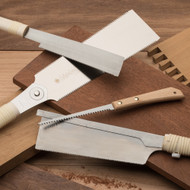When comparing Western and Japanese saws, it’s important to understand that each is designed to function inside a particular tradition — specifically, a particular method of holding and supporting the wood that’s being worked. In the West, woodworkers tend to rely on heavy benches equipped with vises, clamps, holdfasts, and jigs. Japanese workholding, on the other hand, is far more likely to use the woodworker’s body as a workholding device. The Japanese workbench is most often as simple as a beam on a couple of sawhorses or, with some projects, just the floor.
While there are many differences between the two styles of saws, there is no right answer is to which one is better. What makes a saw the correct one is if it's suited for the needs of the project. That's why many experienced woodworkers keep both types in their shops. They are all highly versatile tools that can cut fine dovetails or slice large pieces of lumber. As long as you maintain your tools, they will serve you for years to come. To learn more about sharpening, you can read our guide to sharpening tools.
We also wrote a blog on the different types of Japanese saws you will encounter.



